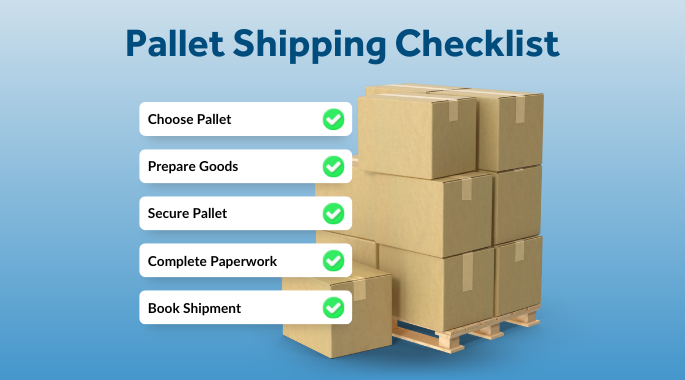Everybody has, at one point or another, shipped something with a courier. Whether it be a letter, a gift, or an online return, courier shipping is a common part of people’s daily lives.
LTL Pallet shipping, on the other hand, is almost exclusively reserved for the commercial sector, and as such, there is much about the process that isn’t immediately clear or well-known in the same way as its smaller-sized counterpart.
At Freightcom, we call ourselves shipping experts for a reason, and that includes knowing a thing or two about how to ship a pallet. We know it can be a little bit daunting, even if it’s something you’ve done before, and we’re here and happy to help.
So, whether you’re shipping your first, fifteenth, or five-thousandth pallet, if you feel that you could use a quick refresher, take a look at our ultimate pallet shipping checklist, and make sure that you’re always prepared to ship.

1. Know Your Pallets
In the same way you’d choose the correct size box to ship your product in, you need to determine the correct pallet to use as well.
To start, let’s get a huge FAQ out of the way: what is the difference between pallets and skids? The short answer is that skids have no bottom slats to act as a base. While this typically makes them lower cost and lighter weight, pallets are better designed for transport, whereas skids are better designed for storage.
Past that, it’s important to know what type of pallet is best to use for your cargo. Wooden pallets are the most commonly used, however plastic, metal, and even biodegradable cardboard-based pallets serve a purpose for shipping specific goods.
2. Prepare Your Goods
Preparing goods to ship via a pallet is a two-fold endeavor, as you must both pack your goods correctly and build your pallet correctly.
If the goods going on your pallet haven’t already been packaged into boxes, ensuring you do so correctly will result in a stronger, more secure pallet during shipping. Be sure to use boxes that are free of tears or creases that can affect the structural integrity and use the correct dunnage to provide ample protection without taking up too much space inside the box.
When building your pallet, it is best practice to stack your goods with the heaviest on the bottom and the lightest on top. If possible, using an interlocking pattern on each layer of goods can help prevent toppling, and using carboard slip sheets between layers can help prevent sliding.
While it is ideal to build a stack of goods that neatly covers the standard 40” by 48” surface area of a pallet, not all goods will have the proper dimensions to accommodate this. In these cases, it is best practice to keep your stacked goods centred on the pallet and avoid overhang on all sides.

3. Secure Your Pallet
Plastic stretch wrap is the most versatile and widely used method of securing your pallet, however occasionally plastic or metal strapping may also be used, often in conjunction with stretch wrap. Plastic strapping is better suited for lighter loads and larger boxes, while metal strapping should be used when transporting masonry goods and machinery.
These straps should be wound along the underside of the pallet and along the top of the load, as well as around the load itself. These should also be used before a pallet is wrapped to avoid tears in the stretch wrap.

4. Complete Your Paperwork
As we’ve discussed on the blog before, proper documentation is arguably the most important part of shipping anything. The documentation that you submit to the carrier, consignee, and any relevant government bodies must be as thorough and accurate as possible.
There is certainly no shortage of documents required for shipping freight, especially when shipping freight cross-border, however the following are the most common documents required for freight shipping, and as such are the documents you should be most familiar with.
Bill of Lading (BOL)
If there is one document above all others that a shipper should familiarize themselves with, it’s the bill of lading. The BOL is the document that serves as the contract between the shipper, carrier, and consignee for goods and services rendered.
Due to the important role of the BOL, it requires plenty of information. An accurate BOL should contain the weight, value, and description of every item in the shipment. Further, the BOL must include the location where the freight will be collected, where it will be transported to, and any special handling instructions that the freight requires.
Customs Invoice
Shippers who plan on shipping from Canada to the US and from the US to Canada will want to familiarize themselves with this document.
A Customs Invoice is a mandatory document used to declare the value of goods on a shipment for it to clear customs.
Customs invoices can also serve as bills of sale on large-volume shipments, in addition to serving as clearance documents. As a customs invoice is not a final request for payment, it can be used as an estimate of the cost of goods sent in advance of a shipment, with a commercial invoice issued once the shipment has been delivered and the final cost agreed upon.
As with the BOL, a customs invoice must include the weight, value, and description of your shipment. In addition, it must list the applicable duties and taxes, country of origin, and harmonized tax code.
Shipping Label
For single pallet shipments, a BOL will often function as a de facto shipping label, so much so that the names can be interchangeable. For multi-pallet shipments, however, shipping labels like those used on parcel shipments may be necessary.
This is likely the last piece of documentation you will encounter when preparing your pallets for shipment, but its importance cannot be understated. Your shipping label contains your shipment’s shipping and return addresses, tracking information, and pallet weight.
Accurate information on your shipping label is as important as both accurate information and the correct postage on a letter’s envelope. It is the first piece of information that your carrier will see, and the piece of documentation that will serve as the main touchpoint for your pallet’s shipping journey.
5. Book Your Shipment (with Freightcom!)
While, admittedly, this step comes before you print your shipping label, it is very much the last major step in your checklist.
Booking a pallet shipment can often be a long, stressful task, especially for those new to pallet shipping. Thankfully, Freightcom makes the process as simple as possible!
Freightcom is Your Pallet Shipping Solution
Freightcom is an all-in-one multimode shipping platform that offers discounted rates on LTL and parcel shipping from North America’s leading carriers. Our easy-to-use platform can help streamline your shipping and help you book your shipments with ease, all for zero startup or monthly fees!
Contact one of our shipping experts today, and see how Freightcom can help you ship smarter, and tick all the boxes on your business shipping needs.


.png?width=250&height=58&name=MicrosoftTeams-image%20(28).png)